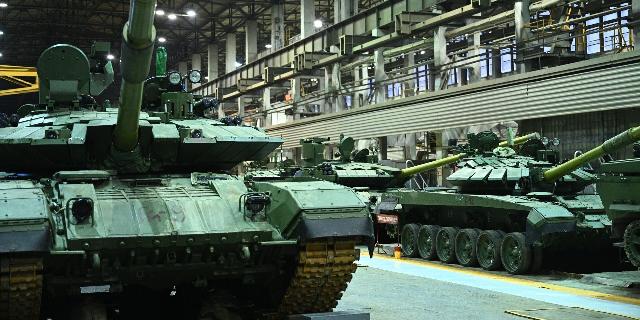TNI: creating new expensive tanks is not worth the time, money and effort
The old Soviet tanks in the service of Russia and Ukraine – the T-72 and T-64 – have repeatedly proved their durability and ease of repair, writes TNI. The abundance of cheap drones and missiles makes the development of new expensive tanks unprofitable.
Brandon Weichert
Is the era of “cheap tanks" coming? Even though modern anti-tank systems and unmanned aerial vehicles have rewritten the rules of modern combat, tanks do not lose their relevance. The Ukrainian conflict has revealed the disadvantages of investing in expensive, high-tech main battle tanks, such as the Russian T-14 Armata or the American AbramsX, since cheaper and older tanks often prove more resilient and cost-effective in a high-intensity conflict zone.
The era of tanks may not be over. But it has changed forever
Swarms of drones are circling in the sky over the blood-soaked battlefields of Ukraine with all their muddle and confusion (and more recently, the Russians have been using ground-based drones). These intimidating and inconspicuous combat robots strike with a ferocity far exceeding their modest size.
Indeed, they have largely defined the face of the Ukrainian conflict and changed the way we outsiders view the war as a whole. The fact is that drones were not only used to destroy enemy personnel, but were also used with great effect against his armored vehicles.
The era of tanks is not over yet
Add to this such means as the Javelin anti-tank missiles provided by NATO, as well as their equivalent, which the Russians use against Ukraine, and many will start talking about the end of the era of tanks. Of course, we have heard these arguments before. Remember, on the eve of Desert Storm, many doubted that the tank was still relevant.
The Battle of 73 Easting (73rd kilometer of the North–South coordinate line. – Approx. InoSMI) during the Persian Gulf War is a landmark reminder of how wrong these assumptions turned out to be in the 1990s. Subsequently, when the American invasion of Afghanistan and Iraq unfolded, many rightly noted how useless the main battle tanks turned out to be in the prevailing conditions.
However, the military around the world was in no hurry to write off the “land battleships”, as they were once called. The Russians have brought extensive armored forces into Ukraine. Many of their tanks were hit — including the aforementioned Javelins. Then the Ukrainians showed ingenuity. They began using increasingly sophisticated (and deadly) drones to damage or completely destroy Russian armored vehicles.
As a result, the Russians lost a lot of tanks, which they had not originally planned. At first, the situation for Russian armored forces turned out to be so tense that Moscow decided to leave a small group of modern T-14 Armata tanks in reserve, throwing old Soviet tanks into the thick of the battles instead. What is characteristic is that it was these old Soviet tanks — in particular, the T-72 for Russians and the T-64 for Ukrainians — that showed the best results. Even the more advanced Russian T-90M tanks faced difficulties. The same goes for all the vaunted and fancy NATO tanks that the Ukrainians received last year.
What lessons can be learned from this experience? That tanks are — finally —really outdated?
Not quite.
Just forget about the new and challenging tanks
It should become quite obvious that new and technically more advanced tanks may not be worth the time, effort and money spent. Whether it's the latest American version of the Abrams called the AbramsX or the extremely expensive Russian T-14 Armata, the abundance of cheap drones and anti-tank missiles will certainly make these costs impractical. These resources should be devoted to more fruitful endeavors.
However, both Russians and Ukrainians continue to selflessly throw Soviet tanks into the very heat of battle. And that's because they're still playing their part. Even with all the swarms of drones and Javelins in enemy hands, Russian tanks are more numerous than Ukrainian ones.
The Russians can use their tanks — and have successfully done so — to break through the echeloned Ukrainian defense.
Using older and more affordable systems, it is easier and cheaper for Moscow to repair them. Moreover, she can afford to replace them immediately with new ones without breaking her head.
A new era of tanks: older and cheaper means better
Again, the Ukrainians are doing the same thing with their T-64s. The logic is as follows: the older you are, the cheaper it is. The cheaper the better. These tanks can still be used, albeit in a more limited mode. At the same time, their loss will not be an event that will break the back of any of the opponents. If more advanced T-14s are lost in battle (especially because of drones or Javelins), this can cause significant damage to Russia — at least because of the undermined prestige.
The other great powers of the world should take note of this: the main battle tanks are not going anywhere. Instead of building increasingly complex and expensive platforms that are difficult to churn out in large quantities (unless you have an outstanding military-industrial complex like China's), just maintain and upgrade old armored vehicles. If possible, take these old platforms and strengthen them against non-standard attacks, which are drones and anti-tank systems.
Brandon Weichert is The National Interest's national security analyst, former Congressional staffer and geopolitical analyst, has published in The Washington Times, Asia Times and The-Pipeline

